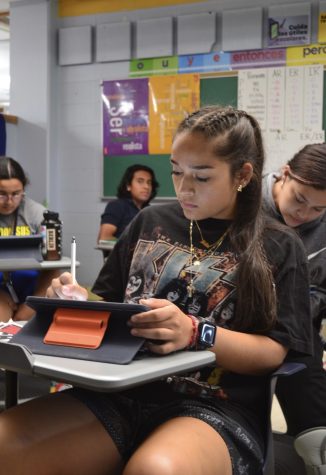Fashion as a Passion
November 18, 2022

You’re at the store picking out some clothes, when your mom says, “Hey, I used to own something that looked exactly like that when I was your age.” You look at her, puzzled. How could that be, you ask yourself. You realize that fashion and style have been a key part of people’s lives for years, and as silly as it might seem, it is what makes us who we are. It’s in our DNA.
For decades, fashion has been at the forefront of culture. It’s intertwined with our identities and everything we do. Lately, teenagers have been embracing this rhetoric, using style and fashion as a way to express themselves to the masses.
Even at Bishop Noll, there has been a rise in the number of students taking their style more seriously. Creativity and uniqueness has seemed to have leaked from almost every fashion subculture imaginable and made its way to the student body.
In a survey of Bishop Noll 108 respondents, the student body thought sophomore Alexandra Magallanes as having the most individual sense of style.
“I’d describe my sense of style as ‘basic girl in a band with black hair and bangs.’ I sort of steal my style from the show Nana and my band mates,” says Magallanes. “I don’t do anything revolutionary in the way I dress, but I do think I do a good job at using my old clothes to fit new trends that come along. Like lots of other teenage girls who like the same bands as me, I wear a lot of random pearls and a lot of different shades of black.”
It’s come to the point where the night before every “jeans day” at Bishop Noll, students will stay up planning the perfect outfits that make them feel like themselves, and convey that to their peers. When asked to complete a survey, a whopping 85-percent of the students who responded admitted that they care and take time out of their day to curate their own personal style.
In a 2009 article by “Newsweek” co-authors Po Bronson and Ashley MerryMan explain the phenomenon of fashion amongst young people.
“…We give adolescents so few outlets to actually express themselves and allow them to find a place in the social hierarchy. The result being that the slightest differences─like a brand of jeans─become invested with an incredible amount of significance.”
Something as simple as a different fit of jeans, or a different length of black shirt can make or break an outfit for someone; it has been this way for years. Since before the oldest teachers at Noll were even born, fashion has persisted as a form of self-expression. The interesting bit, though, is that this new generation, Generation Z, is exploring those decade old trends, but putting their own new twists on them.
When asked on that same survey who BNI students draw inspiration from, some of the answers received would probably seem quite interesting. From ‘90s icons like Kurt Cobain and Aaliyah, to the late Virgil Abloh, and even online influencers such as Drew Phillips, Enya Umanzor, and Ken Ijima, students have been gravitating towards almost every side of the fashion world to draw inspiration for themselves.
“Like every other generation that’s passed, I think Gen Z takes inspiration from the past, but slightly reworks it,” says Magallanes. “Right now, teenagers love to watch movies from the nineties. I think our generation’s love for consuming older media is heavily influencing our collective style.”
In recent years, though, it’s been harder and harder to fit the style of Gen Z in a box. With so many outlets for inspiration available thanks to social media, there is a seemingly endless amount of niche fashions seen through the halls. There is no straight-cut way to describe Gen Z’s fashion as a whole, which is what probably makes it the most interesting.
In the survey, one anonymous junior respondent said, “My sense of style is kind of weird in a way. I don’t think I have a certain type of style. I think I take some of the things I like in other styles, and put them into my own.”
This seems to be the general consensus with most young people. They don’t really know where their style comes from…and they don’t really care to fit themselves into a category. When asked to describe their fashion, survey respondents generally had a very “I don’t really know?” or “depends” stance on their style of dress.
Even though the members of Gen Z prove to not even really understand where they fit in on the fashion scale, and that no two people could ever possibly have the same exact personal tastes, that’s not what anyone is really concerned with. The defining characteristic of the youth has become the openness to the bonds and newfound respect that fashion creates, no matter of personal preferences.
People, especially teenagers, like to feel unique and show their interests and ideas with their clothes,” says Magallanes. “People tend to dress in a way they feel is different, but different in a way they can identify those who have a similar style, which oftentimes leads people to bond or interact over their shared interests.”
So the next time you’re out shopping with you mom, and she stops you to talk about “what she wore back in her day” think about how it’s taken decades of individuals, each with their own individual fashion, to bring what you may just see as another skirt or another cut of t-shirt. Fashion is an ever-evolving, reconstructed cycle, and Gen Z has just taken a particular liking to that rhythm.
